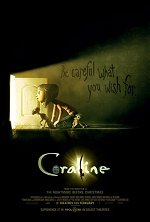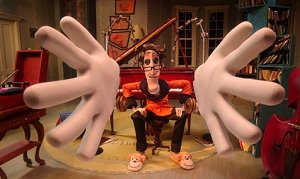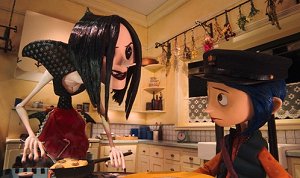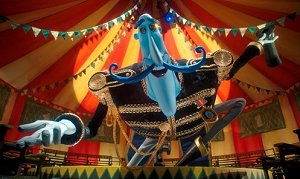 |
|
At The Picture Show
|
February 2009
The nightmare before bedtime
Selick does Gaiman in excellent 'Coraline' adaptation . . . just don't see it in 3-D

Coraline
Focus Features
Director: Henry Selick
Screenplay: Henry Selick, based on the book by Neil Gaiman
Starring: The voices of Dakota Fanning, Teri Hatcher, John Hodgman, Keith
David, Jennifer Saunders, Dawn French and Ian McShane
Rated PG / 1 hour, 40 minutes


 (out of four)
(out of four)
Two things are at play with this month's release of Coraline. First, it is the third
attempt just in the last few years to bring Neil Gaiman's work to the screen,
following in the footsteps of MirrorMask and Stardust.
Second, it is a referendum on the improved 3-D processes that will allegedly
change the moviegoing experience.
 Let's start with the first one. This seems to be the
most successful Gaiman adaptation yet. I've only seen parts of MirrorMask and
the general reception was underwhelming; Stardust was quite imperfect but quite a
bit of fun, too. Coraline is not without its problems, but is thoroughly enjoyable,
full of inventiveness and vitality.
Let's start with the first one. This seems to be the
most successful Gaiman adaptation yet. I've only seen parts of MirrorMask and
the general reception was underwhelming; Stardust was quite imperfect but quite a
bit of fun, too. Coraline is not without its problems, but is thoroughly enjoyable,
full of inventiveness and vitality.
Now, to the second part, which we will discuss and then mention no more. 3-D
continues to insist upon itself, and always finds other people to insist right along
with it. Like Dennis Kucinich.
The truth, now that I've seen Coraline, is that the rumors of its vast improvement
have been greatly exaggerated. It still isn't very far removed from the 3-D that I
saw five years ago, or ten years ago. I was far too young for Jaws 3-D or Friday
the 13th Part 3, so I won't go that far back. It's not simply that the current
permutation leaves something to be desired - it's that it still has us wondering,
Why?!
There is very little, if anything, in Coraline that couldn't be experienced just as
well in traditional 2-D - or, in fact, better. It is a treat to look at in and of itself,
and it's a testament to the animation, not the projection process.
 There were a few slight instances that were of
some interest - the effect of looking through a window from the outside, or looking
through the bushes at the title character, created a layered effect different from the
usual. But those are only small, specific moments, and certainly not worth
spending the rest of the movie wearing glasses that may or may not hurt our eyes
or give us a migraine.
There were a few slight instances that were of
some interest - the effect of looking through a window from the outside, or looking
through the bushes at the title character, created a layered effect different from the
usual. But those are only small, specific moments, and certainly not worth
spending the rest of the movie wearing glasses that may or may not hurt our eyes
or give us a migraine.
The 3-D does not improve our understanding of each shot's depth of field - good
composition can do that by itself. Things popping out toward the screen at us?
That was amusing when we were four and it was a shark. Other than that, 3-D
serves no purpose. I can think of no movie that I have ever seen, good or bad, that
would have been improved by the 3-D process. (In my light research, I discovered
that the 1954 film The French Line, starring Jane Russell, was shown in 3-D. I
would be interested in seeing this one, but only for two very specific reasons.)
But oh yeah, back to the movie itself. Coraline is a thoroughly charming fantasy
that features a few sequences astonishing in their creative breadth and detail. The
story can be described as little more than quaint - girl moves into new house,
parents are distant, she discovers entrancing "other" version of her parents, which
turns out to be sinister - as the greatest interest lies in what director Henry Selick
(and, of course, Gaiman) can create with every scene.
 The results are often wonderful. I found myself
completely enraptured by ideas, while largely disengaged from the story - which
flows by as little more than as a vehicle to get to all those great ideas and setpieces.
To explain them all, or even my favorites, would be doing them a disservice. They
are dream-like and nightmare-like, they are ominous and cheerful and absurd and
kaleidoscopic and scary and strange. There you have it.
The results are often wonderful. I found myself
completely enraptured by ideas, while largely disengaged from the story - which
flows by as little more than as a vehicle to get to all those great ideas and setpieces.
To explain them all, or even my favorites, would be doing them a disservice. They
are dream-like and nightmare-like, they are ominous and cheerful and absurd and
kaleidoscopic and scary and strange. There you have it.
I am only familiar with Gaiman's work by reputation. I haven't yet read any of his
work, though I'm anxious to start. Judging solely from Coraline and Stardust, he
seems to have an almost-bottomless well of ideas but less regard for any originality
of story. Neither of those two films could be any more predictable. But several
individual sequences, on the other hand, completely subvert custom or find wholly
unpredictable ways to handle old material. It's those moments, in both films, that
stand out - they are absolute marvels of creation. The story arc could just as well
be forgotten about.
Either the character development is weak or the story is uninteresting - but the
films as a whole are neither. If you offered me a bit more character exploration in
Coraline and Stardust at the expense of all the imagination on display, I'd tell you
to shove it.
Read more by Chris Bellamy